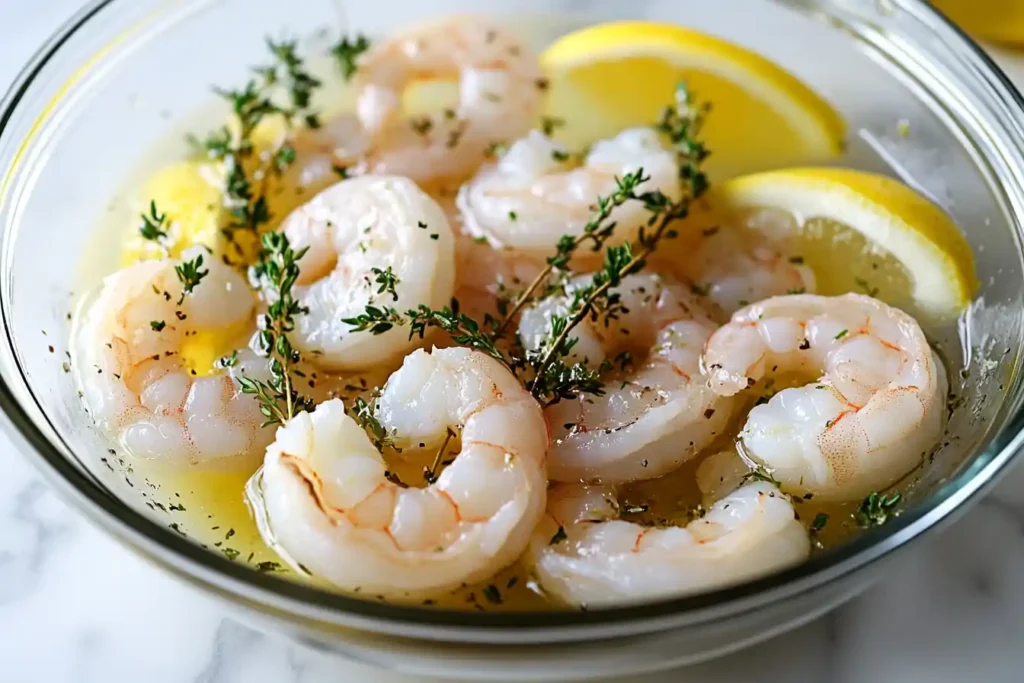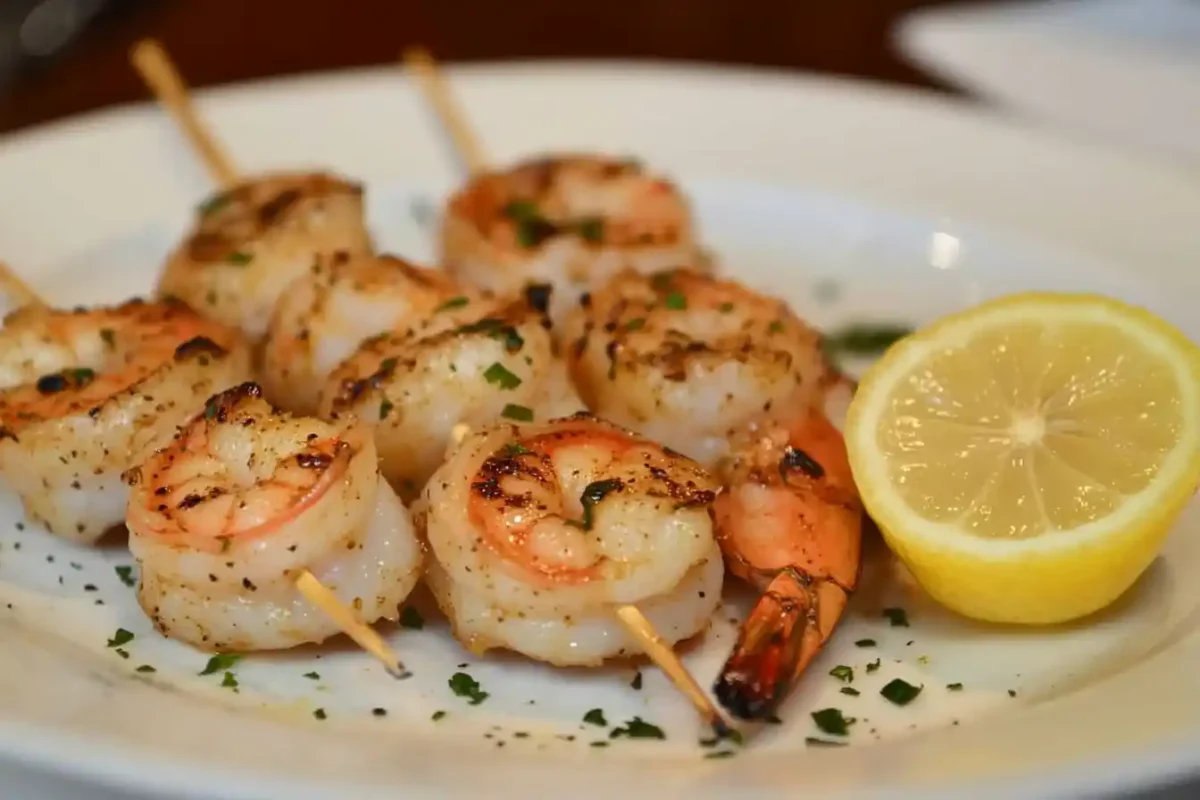Understanding the Basics of Grilling Shrimp
Choosing the Right Type of Shrimp
When it comes to grilling, not all shrimp are created equal. While frozen shrimp are convenient, fresh shrimp often have a more robust flavor and firmer texture. However, if you’re using frozen shrimp, make sure they’re raw and labeled “deveined” for an easier prep.
Fresh vs. Frozen Shrimp
Fresh shrimp are ideal if you have access to a seafood market, but for most home cooks, frozen shrimp are perfectly fine—and more accessible! Look for “individually quick frozen (IQF)” shrimp to ensure they’re frozen at peak freshness. Avoid pre-cooked shrimp since they’ll turn rubbery when grilled.
Shrimp Sizes and Their Importance
Shrimp sizes are typically labeled as “jumbo,” “large,” “medium,” or “small.” For grilling, larger shrimp, such as jumbo or colossal, work best since they’re less likely to fall apart. These sizes also retain moisture better on high heat. Smaller shrimp may be tempting, but they’re better for sautéing or stir-frying.
Peeled vs. Unpeeled Shrimp
Leaving the shell on while grilling shrimp adds a protective layer that helps lock in moisture. Plus, it makes the shrimp more flavorful. If you prefer ease of eating, you can peel them beforehand—but keep the tails for added flavor and presentation!
Preparing Shrimp for Grilling
Great grilled shrimp starts with good prep. If you skip this step, no marinade or seasoning can save you! Proper cleaning, deveining, and seasoning are the secret weapons to achieving delicious results.
Deveining and Cleaning Shrimp
To devein, make a shallow slit along the shrimp’s back and remove the dark vein (which is actually the digestive tract). Rinse thoroughly to remove any grit. Even if the shrimp looks clean, it’s worth the extra step. Trust me—you’ll taste the difference!
How to Skewer Shrimp Properly
Skewering shrimp keeps them from falling through the grill grates. Use metal skewers for convenience or soak bamboo skewers in water for at least 30 minutes to prevent burning. For even cooking, thread the shrimp through both the top and bottom, creating a “C” shape.
Marinating Tips for Flavorful Shrimp

A good marinade can elevate shrimp from ordinary to unforgettable. Shrimp absorb flavors quickly, so marinate them for 15-30 minutes max. Too long, and the acidic elements (like lemon or lime) can start “cooking” the shrimp, turning them mushy. Popular flavors include lemon-garlic, Cajun spice, and cilantro-lime.
Essential Equipment for Grilling Shrimp
You don’t need fancy tools, but certain essentials make the process smoother and more enjoyable.
- Grills: Whether you’re using a charcoal, gas, or electric grill, the key is to preheat it to high heat.
- Skewers: Metal skewers are reusable and don’t catch fire. Bamboo skewers work too—just don’t forget to soak them!
- Grilling Tools: A good pair of long-handled tongs, a grill brush for cleaning, and a basting brush for brushing on oil or marinade are must-haves.
Understanding the Basics of Grilling Shrimp
Choosing the Right Type of Shrimp
Fresh vs. Frozen Shrimp
When deciding between fresh and frozen shrimp, consider convenience versus flavor. Fresh shrimp from the seafood counter often have a delicate, sweet taste and firm texture. However, don’t write off frozen shrimp—they’re typically flash-frozen right after harvest, locking in freshness. Just make sure to thaw them in the refrigerator rather than at room temperature to maintain their quality. Avoid pre-cooked shrimp as they’re prone to becoming rubbery when grilled.
Shrimp Sizes and Their Importance
Size matters when grilling shrimp! Large or jumbo shrimp (16–20 per pound) are ideal because they hold up well over high heat and are less likely to overcook. Medium shrimp can work but require extra attention to prevent overcooking. Smaller shrimp (like salad shrimp) aren’t the best for grilling since they’re too delicate and can easily fall apart or slip through the grates.
Peeled vs. Unpeeled Shrimp
Should you grill your shrimp with the shell on? It depends! Shell-on shrimp help lock in moisture and add a subtle briny flavor during cooking. However, some people prefer peeled shrimp for easier eating. A good compromise is to leave the tails on while removing the body shell. The tails act as built-in handles and add visual appeal—especially for party platters!
Preparing Shrimp for Grilling
Deveining and Cleaning Shrimp
Deveining shrimp might seem like a chore, but it’s worth the effort. Slice along the back of each shrimp to remove the vein, which is often gritty. Rinse the shrimp under cold water after deveining to ensure they’re thoroughly cleaned. For extra freshness, pat them dry with paper towels—shrimp that are too wet can steam instead of sear on the grill.
How to Skewer Shrimp Properly
Skewering shrimp helps keep them in place and makes flipping them easier. Thread each shrimp through both the thickest part of the body and the tail end to create a secure “C” shape. This ensures the shrimp stay put when you flip them and cook evenly. If you’re using bamboo skewers, soak them in water for 30 minutes to prevent burning. Metal skewers, on the other hand, are reusable and won’t catch fire—a great option for frequent grillers.
Marinating Tips for Flavorful Shrimp
A well-balanced marinade can make your shrimp irresistible. Since shrimp absorb marinades quickly, 15 to 30 minutes is all you need. For a citrus-based marinade, opt for fresh lime or lemon juice paired with olive oil, garlic, and herbs. You can also learn the best way to barbecue shrimp to keep it moist and flavorful.Prefer something bolder? Try Cajun seasoning or a garlic butter mix with paprika for a smoky kick. Avoid marinating shrimp too long, though, as acidic ingredients can “cook” the shrimp and make them mushy.
Essential Equipment for Grilling Shrimp
- Grills: Whether you use charcoal, gas, or electric, preheating your grill to high heat (around 400°F) is crucial for a good sear. Charcoal grills impart a smoky flavor, while gas grills are easier to control. Electric grills are great for apartment balconies but may lack that “grilled” charred flavor.
- Skewers: Metal skewers are durable and reusable, while bamboo skewers are disposable but must be soaked in water to prevent them from burning.
- Essential Grilling Tools: Long-handled tongs are perfect for flipping shrimp without burning yourself. A grill brush keeps your grates clean, and a silicone basting brush helps you coat your shrimp with marinade or butter without losing bristles.
Secrets to Perfectly Grilled Shrimp
The Ideal Grilling Temperature and Cooking Time
Temperature Ranges for Different Grills
Getting the temperature right is one of the secrets to grilling shrimp perfectly. Aim for medium-high heat, around 375°F to 400°F. For charcoal grills, this means letting the coals ash over before spreading them evenly. Gas grills should be preheated for about 10 minutes with the lid closed. Electric grills tend to heat quickly but may not reach as high as gas or charcoal, so keep the shrimp closer to the hottest point. Maintaining consistent heat is key to preventing uneven cooking or charring. You can also explore different shrimp cooking methods to suit your taste preferences.
Why Overcooking is the Most Common Mistake
Shrimp cook fast—usually within 2 to 3 minutes per side, depending on their size. Overcooking them, even by a minute, can turn that tender, juicy texture into something dry and rubbery. Keep an eye on their color; shrimp start out gray and translucent but turn pink and opaque when done. Another tell-tale sign? Their bodies will curl into a loose “C” shape. If they’re forming a tight “O,” they’ve been overcooked! To avoid this common grilling pitfall, set a timer and remove shrimp from the grill as soon as they change color and form that perfect “C.”
How to Season Shrimp for Maximum Flavor
Balancing Acidity and Spices in Marinades
A great marinade combines three essential components: acidity, fat, and seasoning. The acidity—such as lemon juice, lime juice, or vinegar—brightens the shrimp’s natural sweetness. But too much acid can break down the shrimp’s protein structure, making them mushy. Pair acids with olive oil or melted butter to balance the flavors and help the seasoning stick. Finally, choose complementary spices, like garlic, smoked paprika, or chili flakes, to enhance the shrimp’s depth of flavor without overpowering it.
Popular Seasoning Combinations (Garlic Butter, Cajun, Lemon Herb)
- Garlic Butter Shrimp: Melted butter mixed with minced garlic, parsley, and a pinch of red pepper flakes makes for a rich, savory coating that clings beautifully to the shrimp.
- Cajun Shrimp: A blend of smoked paprika, cayenne, garlic powder, and onion powder gives shrimp a bold, smoky heat that pairs perfectly with grilled corn or rice.
- Lemon Herb Shrimp: Lemon zest, fresh rosemary, thyme, and a drizzle of olive oil create a light, refreshing flavor profile—perfect for summer BBQs or lighter meals.
Each of these combinations enhances the shrimp’s natural sweetness while adding a unique flavor punch. Just remember, a little seasoning goes a long way!
Grilling Techniques to Avoid Sticking and Burning
Preheating the Grill Correctly
Before placing your shrimp on the grill, make sure the grates are properly preheated. A preheated grill prevents shrimp from sticking and helps create those beautiful grill marks. Preheat your grill for at least 10 minutes with the lid closed. You’ll know it’s ready when you can hold your hand about 5 inches above the grates and only last 2 to 3 seconds before pulling away.
Oil Application and Grill Maintenance
Lightly oiling the grill grates helps create a non-stick surface. But don’t go overboard—a quick swipe with an oil-soaked paper towel using long tongs will do the trick. Too much oil can cause flare-ups. Similarly, make sure your grill is clean before cooking. Burnt residue from previous meals can cause sticking and impart unwanted flavors. Scrub the grates with a grill brush after preheating and before cooking your shrimp.
Flipping and Timing During Grilling
When grilling shrimp, timing is everything. Only flip the shrimp once during cooking—after 2 to 3 minutes on one side. Flipping too frequently can cause them to lose moisture and fall apart. Once flipped, cook for another 2 minutes until they’re opaque and pink. Avoid overcrowding the grill; give each shrimp space so they can cook evenly and get that slightly crisp outer layer.
Achieving That Perfect Grill Mark
Best Practices for Searing
To achieve those crave-worthy grill marks, don’t move the shrimp immediately after placing them down. Press them gently against the grill grates for 20 to 30 seconds to sear them in place, ensuring they don’t stick. Shrimp that’s left undisturbed for the right amount of time will develop those beautiful, golden-brown char lines that add both flavor and presentation value.
Positioning Shrimp on the Grill Grates
The placement of shrimp on the grill makes a big difference. Position the skewers or shrimp diagonally across the grates for the best sear and aesthetic grill marks. Keeping the shrimp in the hotter zones of the grill (direct heat) helps them cook faster and prevents them from steaming.
Additional Tips and Serving Suggestions
Common Mistakes to Avoid When Grilling Shrimp
Using Too Much Marinade or Oil
While marinades add amazing flavor, too much can backfire. Shrimp only need a thin coating of marinade—just enough to enhance their taste without dripping excessively onto the grill. Excess marinade can lead to flare-ups, causing uneven charring or burning. The same goes for oil—lightly brushing or tossing the shrimp with oil is sufficient to prevent sticking without overwhelming their natural flavor. When using oil-based marinades, remember that less is more!
Crowding the Grill Skewers
It’s tempting to pack shrimp tightly together on skewers to fit more on the grill, but this prevents even cooking. When shrimp are crowded, they steam rather than sear, leading to soggy, pale shrimp instead of crisp, beautifully charred ones. For the best results, leave a small gap between each shrimp so the heat can circulate and cook them evenly.
Not Accounting for Residual Heat
Shrimp continue to cook slightly after being removed from the grill due to residual heat. If you wait until they’re fully opaque before pulling them off, they’re likely to overcook. Instead, remove the shrimp just before they’re fully cooked (when they’re mostly pink but still slightly translucent in the center). Let them rest for a minute or two—they’ll finish cooking perfectly on the plate!
How to Pair Grilled Shrimp with Delicious Sides
Nutritional Information for Grilled Shrimp (Per 100g)
| Nutrient | Amount |
|---|---|
| Calories | 99 kcal |
| Protein | 24g |
| Total Fat | 1g |
| Saturated Fat | 0.2g |
| Cholesterol | 189mg |
| Sodium | 111mg |
| Total Carbohydrates | 0g |
| Dietary Fiber | 0g |
| Sugars | 0g |
Sides for BBQ Parties (Coleslaw, Cornbread, Grilled Veggies)
Pairing grilled shrimp with the right sides takes your BBQ game to the next level! Classic coleslaw, with its creamy dressing and crisp veggies, balances the smoky, savory flavor of the shrimp. Cornbread, with its sweet, crumbly texture, is another great option, especially for Southern-inspired shrimp dishes. If you want to keep things light but flavorful, grilled vegetables like zucchini, bell peppers, and mushrooms add a smoky, charred complement to the shrimp while keeping the meal colorful and healthy.
Healthy Options (Quinoa Salad, Asparagus, Lemon Rice)
For healthier pairings, consider a quinoa salad tossed with fresh cucumbers, tomatoes, and a lemon vinaigrette—it’s refreshing and packed with protein. Grilled asparagus spears drizzled with olive oil and a sprinkle of sea salt offer a perfect low-carb side. Lemon rice is another favorite, thanks to its zesty brightness that complements shrimp’s rich, buttery flavor. These options strike the perfect balance between satisfying and light!
Storing and Reheating Leftover Grilled Shrimp
How to Store Shrimp Safely
To store leftover shrimp, place them in an airtight container and refrigerate them within 2 hours of cooking. Shrimp can be stored in the fridge for up to 3 days. For longer storage, you can freeze the shrimp in a sealed freezer-safe bag for up to 3 months. To avoid freezer burn, make sure to remove as much air as possible from the bag before sealing.
Best Methods for Reheating Without Losing Flavor
Reheating shrimp can be tricky since they can dry out quickly. The best method is to warm them gently in a skillet over medium-low heat with a splash of water or broth, just like when reheating a chicken and dressing recipe to maintain tenderness.. Covering the skillet helps the shrimp stay moist as they reheat. You can also reheat shrimp in the microwave, but do it in short, 15-second bursts to avoid overcooking. If you’re short on time, enjoy the shrimp cold—tossed in a salad or served as a shrimp cocktail!
Frequently Asked Questions About Grilling Shrimp
How long should shrimp be grilled for?
Shrimp cook incredibly fast—typically just 2 to 3 minutes per side. Larger shrimp may take closer to 4 minutes total, but anything longer risks drying them out. The key is to watch for the shrimp to turn pink and opaque, with slight charring along the edges. To be safe, set a timer and flip the shrimp as soon as the undersides develop grill marks. Overcooking is the most common mistake, so keep a close eye!
What’s the best shrimp size for grilling?
When it comes to grilling, bigger is better! Jumbo or colossal shrimp (16–20 per pound) hold up well to high heat without falling apart. Their larger size also makes flipping them easier and prevents them from slipping through the grill grates. Medium shrimp can work, but they require skewering to prevent loss. Avoid small shrimp for grilling as they’re more suited for sautés or stir-fries.
Do you grill shrimp with or without the shell?
Both options work, but it depends on your preference. Leaving the shell on helps protect the shrimp from direct heat, locking in moisture and adding a subtle briny flavor. However, peeled shrimp absorb marinades better and are easier to eat. But if you’re unsure, learn the benefits of grilling shrimp with the shell on.For a happy medium, peel the body but leave the tails on for a clean look and convenient handling. Shell-on shrimp are perfect for large gatherings where presentation matters.
How do you know when shrimp are done cooking?
Shrimp are done when they’ve turned opaque and pink, with reddish accents where the shells remain. They should curl into a loose “C” shape—not a tight “O,” which indicates overcooking. Another tell-tale sign is the texture: perfectly cooked shrimp will feel firm but not rubbery. To play it safe, remove the shrimp from the grill just before they look fully cooked, as they’ll continue to cook slightly from residual heat.
Conclusion Of Grilling Shrimp
Mastering the art of grilling shrimp doesn’t have to be intimidating. With the right preparation, seasoning, and attention to detail, you can achieve shrimp that’s tender, flavorful, and perfectly charred every time. Remember to choose larger shrimp, avoid over-marinating, and preheat your grill for best results.
Don’t be afraid to experiment with different marinades—whether it’s a citrusy lemon-herb mix for a light meal or a bold Cajun blend for some heat. Pair your shrimp with delicious sides like grilled veggies, lemon rice, or quinoa salad to create a memorable, well-rounded meal.
For more grilling inspiration, check out other seafood recipes, from grilled salmon to skewered scallops, to expand your backyard BBQ menu. Shrimp are just the beginning! Ready to impress your guests? Fire up the grill and enjoy the smoky, juicy perfection that only grilled shrimp can offer.

